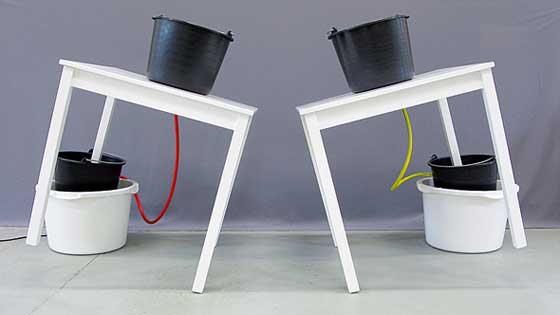|
|
| The waterman Jānis Borgs, Art Critic Aldo Kroese. Back Flow 07.08.–29.08.2010. kim? Gallery RIXC | |
| He comes from a land where water is one of the dominant elements, the driver of development and potential bringer of destruction. Colloquially it is called Holland, but more officially it is the Netherlands. This fact leads to somewhat banal motivations being sought as to why Aldo Kroese uses water as the ‘building material’ for his art. Clearly, if the artist were Mongolian, then art admirers would refer to the desert, camels and a scarcity of fluid. But we will look at H²O without unnecessary poetic fancy, as a substance that is not only useful for scientific research, but can also be turned into an expressive and meaningful vehicle of artistic activity. Aldo Kroese does this with witty elegance in his exposition of installations Back Flow, currently on display at the popular Riga arts centre kim?. In the exhibition space, we are met with an arrangement of apparently routine and well-known everyday objects, including various chairs, wheelbarrows and other household objects. The artist has observed one common feature of construction: the structure’s ‘skeleton’ is formed from curved tubes, a continuation of the functional design of the 1920s. And if we have a pipe at our disposal, then it can be given an extra mission – to serve as a water pipe. Thus objects near and dear to us are placed in upside-down positions in an environment uncharacteristic to them, in various water tubs, containers, buckets... The open pipe ends are connected to small, brightly-coloured rubber hoses. The snout of the hose sinks into a squelchy volume of water, the electric ‘motor heart’ is chugging and the pump is giving a new and strange life to the objects. A stream of water spouts smoothly from one end of a chair leg or a wheelbarrow handle. It flows into the tank it came from to restart a new circular cycle of movement... | |
 Aldo Kroese. Untitled (Back Flow). Installation. 2010. Courtesy: Aldo Kroese | |
| Although there is a certain sense of an aesthetic code bestowed by a ‘higher creator’ in the overall appearance of the arrangement of objects, all of the installations exhibit something of the imagery of large insects or aquatic animals, whose ‘life’ functions have their own autonomy, independently of humans. But this is quite a literary association. It seems that the emotional tone of the exhibition – the Laboratory – is far more important. This isn’t Handel’s Water Music. Some sort of almost criminal, secret experiments, in the vein of Dr Frankenstein or Dr Caligari, are wafting in the arches of the gallery. And maybe all of them, these unclassified and alien techno-bio creatures will come back to life from their mechanical trance and throw themselves at you... At the exhibition the group of installations has been shaped into a powerful, exciting and theatrical ensemble, which from the very first moment ‘grabs’ the viewer with its hypnotic charm. This mood is further reinforced by a mysterious squelching, dripping, steaming, vibrating of devices placed on a separate table where the artist, like an alchemist in search of some elixir of life or gold, is experimenting with the different states and characteristics of water. Their revelation alongside the ‘mystical’ aspects please us with their strangeness and the beauty of the processes. No matter how emphatically technical or seemingly unrelated to art the installations and devices kept in this Laboratory may be, their aura has a certain shadow of aestheticism. Which, incidentally, is not necessarily a requirement of such ‘plumbing’ artefacts. In the form of the artist’s installations one can still perceive a certain shortage of ambitious confidence, a more monumental approach, ‘aggression’ of imagery. It can be stated with certainty that there are exceptionally deep reserves for development here, as long as the author is not overtaken by the navel-gazing and the infection of marginality so widespread in avant-garde art. The power of expressiveness is something that comes with greater experience, and there is fertile soil for talent here. Aldo Kroese is a lecturer at the Gerrit Rietveld Academy in Amsterdam. The reference to the great figure of Dutch constructivism in Kroese’s works reminds us once again of the artist’s indirect links with the De Stijl movement, so influential in contemporary European culture. The visual intelligence in Kroese’s installations relates to the long cultivated traditions of art in the Netherlands. And we can be proud that once more a new artistic personality has appeared at kim? and onto our art scene. /Translator into English: Filips Birzulis/ | |
| go back | |







